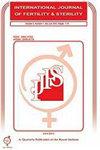高粘稠男性精液中DNA、蛋白质、脂质氧化和凋亡生物标志物水平的横断面研究
IF 2.3
Q2 OBSTETRICS & GYNECOLOGY
International Journal of Fertility & Sterility
Pub Date : 2023-04-01
DOI:10.22074/IJFS.2022.546434.1249.
引用次数: 0
摘要
背景:精液高粘稠度是男性精子异常和不育的危险原因。我们的目的是评估氧化应激、抗氧化剂消耗和精子凋亡是高粘稠精液男性精子质量差的主要原因。材料和方法:在这项横断面研究中,收集了精液高粘稠(n=123)和无精液高粘稠(n=143)的可生育(n=102)和不育(n=123)男性的射精标本。测定精液样品中的总抗氧化能力(TAC)、谷胱甘肽(GSH)、丙二醛(MDA)、蛋白羰基(PC)、8-羟基脱氧鸟苷(8-OHdG),以评估氧化应激状态。评估BAX、CASPASE-9、CASPASE-3和BCL2基因表达模式,评估精子凋亡。结果:精液高粘稠者精子数量、形态、活力平均值显著低于无高粘稠者(P<0.01)。高粘稠精液男性的PC(8.34±1.03 nmol/mg vs. 6.01±0.93 nmol/mg, P=0.008)、MDA(1.14±0.27 nmol/ml vs. 0.89±0.22 nmol/ml, P=0.031)、8-OHdG(259.71±24.59 ng/ml vs. 197.13±18.47 ng/ml, P=0.009)含量高于无粘稠精液男性,TAC(1250.44±66.23 μM/L vs. 1784.31±89.87 μM/L, P=0.018)和GSH(3.82±1.05 μM vs. 5.89±0.87 μM, P=0.021)含量低于无粘稠精液男性。BAX、CASPASE-3和CASPASE-9基因在高粘稠精液男性中的表达比无高粘稠精液的不育者分别显著增加1.39倍(P=0.041)、1.47倍(P=0.046)、1.29倍(P=0.048)。然而,无高粘稠精液的不育男性BCL2表达高于高粘稠精液的男性(1.36倍,P=0.044)。结论:高粘稠精液与精浆抗氧化剂消耗、精子膜脂过氧化、DNA和蛋白质氧化及精子凋亡密切相关。抗氧化治疗可能被认为是一种有价值的策略,以保护精子细胞免受精子高粘度的氧化损伤。本文章由计算机程序翻译,如有差异,请以英文原文为准。
Levels of DNA, Protein, Lipid Oxidation and Apoptosis Biomarkers in Semen of Men with Hyperviscous Semen: A Cross-Sectional Study
Background: Semen hyperviscosity is a threatening cause of abnormal spermatozoa and infertility in men. We aimed to evaluate oxidative stress, antioxidants depletion and sperm apoptosis as main reasons for poor quality of spermatozoa in men with hyperviscous semen. Materials and Methods: In this cross-sectional study, ejaculate specimens were collected from fertile (n=102) and infertile men with hyperviscous semen (n=123) and without semen hyperviscosity (n=143). Total antioxidant capacity (TAC), glutathione (GSH), malondialdehyde (MDA), protein carbonyl (PC), 8-hydroxydeoxyguanosine (8-OHdG), and were measured in semen samples to estimate oxidative stress status. Gene expression pattern of BAX, CASPASE-9, CASPASE-3, and BCL2 was assessed to estimate sperm apoptosis. Results: The average of sperm count, normal morphology, normal motility, and sperm vitality in men with hyperviscous semen was significantly lower than infertile subjects without hyperviscous semen (P<0.01). Men with hyperviscous semen exhibited higher levels of PC (8.34 ± 1.03 nmol/mg vs. 6.01 ± 0.93 nmol/mg, P=0.008), MDA (1.14 ± 0.27 nmol/ ml vs. 0.89 ± 0.22 nmol/ml, P=0.031), 8-OHdG (259.71 ± 24.59 ng/ml vs. 197.13 ± 18.47 ng/ml, P=0.009), but lower TAC contents (1250.44 ± 66.23 μM/L vs. 1784.31 ± 89.87 μM/L, P=0.018) and GSH (3.82 ± 1.05 μM vs. 5.89 ± 0.87 μM, P=0.021) than men with non-viscous semen. The expression of BAX, CASPASE-3 and CASPASE-9 genes in men with hyperviscous semen was significantly increased by 1.39-fold (P=0.041), 1.47-fold (P=0.046), 1.29-fold (P=0.048), respectively, as compared with the infertile subjects without hyperviscous semen. However, BCL2 expression in infertile men without hyperviscous semen was higher compared to those with hyperviscous semen (1.36-fold, P=0.044). Conclusion: Hyperviscous semen is markedly associated with depletion of seminal plasma antioxidants, sperm membrane lipid peroxidation, DNA and protein oxidation, and sperm apoptosis. Antioxidant therapy might be considered as a valuable strategy to protect sperm cells against oxidative damage in cases with seminal fluid hyperviscosity.
求助全文
通过发布文献求助,成功后即可免费获取论文全文。
去求助
来源期刊
CiteScore
4.20
自引率
0.00%
发文量
68
审稿时长
>12 weeks
期刊介绍:
International Journal of Fertility & Sterility is a quarterly English publication of Royan Institute . The aim of the journal is to disseminate information through publishing the most recent scientific research studies on Fertility and Sterility and other related topics. Int J Fertil Steril has been certified by Ministry of Culture and Islamic Guidance in 2007 and was accredited as a scientific and research journal by HBI (Health and Biomedical Information) Journal Accreditation Commission in 2008. Int J Fertil Steril is an Open Access journal.

 求助内容:
求助内容: 应助结果提醒方式:
应助结果提醒方式:


